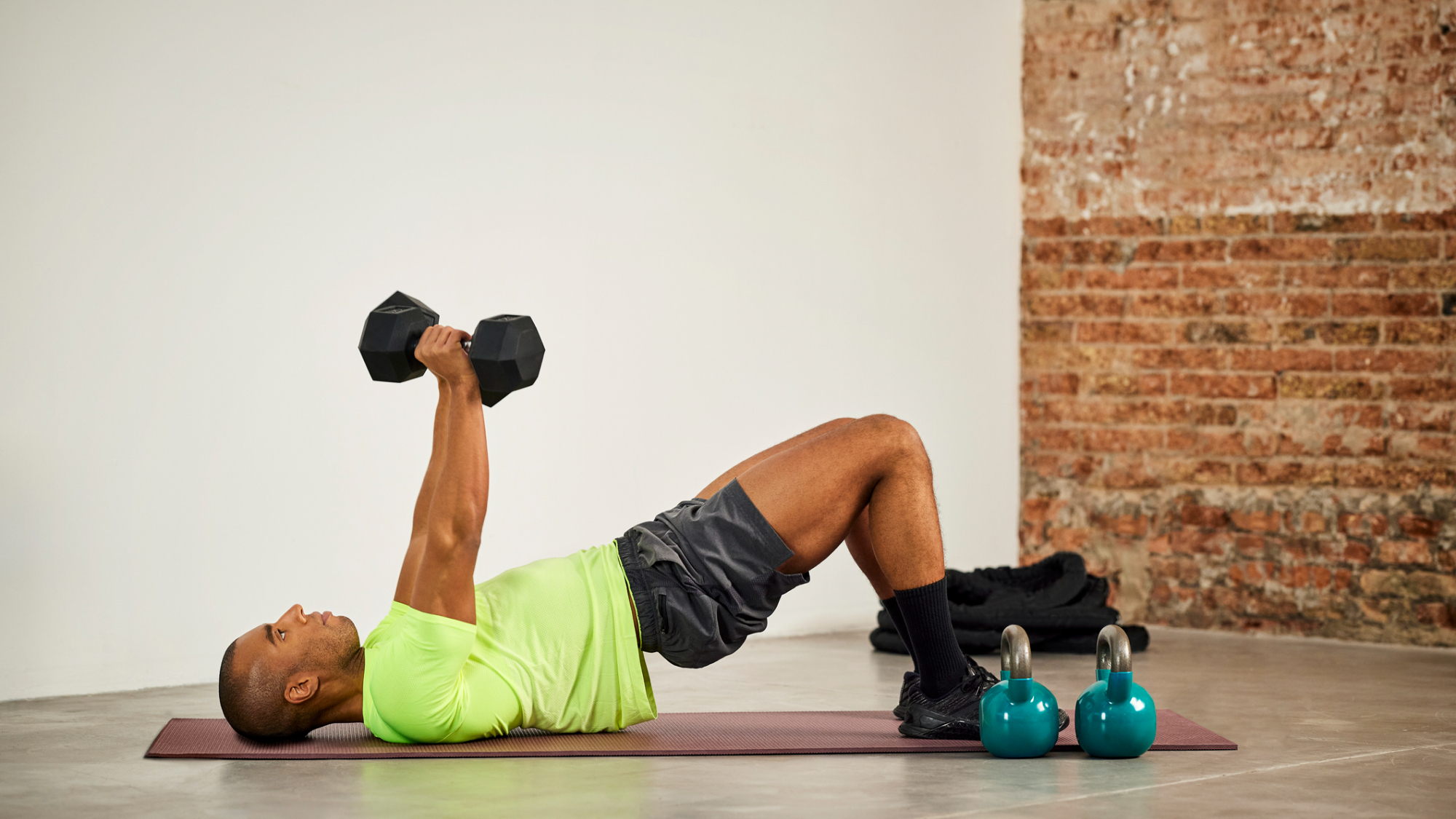It only takes five moves to build full-body strength and develop your core stability
This workout will build the foundations you need for a fit and functional body


If you're new to lifting weights, full-body workouts are the way to go. They allow you to work every major muscle group in one fell swoop, making for a time-efficient training session.
Sound good? Then try this "foundations" session from OneFit trainer Stanislav Kravchenko; it’s designed to develop full-body strength, stable joints and body awareness.
"Our body operates in three planes of motion: sagittal, frontal and transverse," Kravchenko explains.
Most exercises challenge us to move in the sagittal plane, moving up, down, forwards or backwards. But we aren’t limited to these movement patterns in daily life—we also need to be able to twist (in the transverse plane) and move from side-to-side (the frontal plane).
"We will cover all of these planes of motion and target the lower body, upper body and core in this workout," Kravchenko says. "That’s why I call it 'foundations'."
You don’t need a lot of equipment to do the workout, just a couple of dumbbells and a mat for added cushioning during floor-based exercises.
How to do Stan Kravchenko’s Foundations workout
- Goblet squat: 3x6-12
- Glute bridge dumbbell floor press: 3x15
- Single-arm dumbbell bent-over row: 3x12 (each side)
- Alternating curtsy lunge with dumbbells: 3x10 (each side)
- Dumbbell lateral raises: 3x15
Perform the five exercises listed above in straight sets. This means you’ll perform one set for the prescribed number of repetitions, rest, then complete another set. Continue this until you’ve done all sets, then move on to the next exercise.
Start your week with achievable workout ideas, health tips and wellbeing advice in your inbox.
1. Goblet squat
Sets: 3 Reps: 6-12 Rest: 60-90 seconds
- Stand upright with your feet about hip-width apart and your toes pointed outwards slightly, cupping a dumbbell in both hands tight to your chest.
- Keeping your chest up and your back straight, push your hips back and bend your knees as if you were sitting into a chair behind you.
- Lower your hips as far as you can while keeping your chest up, then drive through your feet to return to the starting position.
Benefits of the goblet squat
"This works all the lower body muscles, such as the quads, glutes and hamstrings. It also helps improve core stability and balance," says Kravchenko.
"Holding the weight in front of you allows for a better range of motion, keeps your torso upright and reduces the impact on the lower back."
2. Glute bridge dumbbell floor press
Sets: 3 Reps: 15 Rest: 60-90 seconds
- Lie on your back with your feet flat on the floor, roughly hip-distance apart, and your knees pointed upwards. Hold a dumbbell in each hand and extend your arms directly upwards so your hands are above your chest. Brace your core and lift your hips so your torso and thighs form a straight line. This is your starting position.
- Keeping your elbows tucked into your sides, lower the dumbbells to your chest, then push them back up to the ceiling. That’s one repetition.
- Once you’ve completed all repetitions, lower your hips to the floor.
Benefits of the glute bridge dumbbell floor press
"This exercise combines a glute bridge—targeting your glutes and hamstrings—with a floor press—which works your chest, shoulders, and triceps," Kravchenko explains. "It's an excellent way to engage your core as well."
3. Single-arm dumbbell bent-over row
Sets: 3 Reps: 12 (on each arm) Rest: 60-90 seconds
- Stand upright with a dumbbell in your right hand, then hinge at the hips to bend over so your back is flat and almost parallel with the ground, allowing the dumbbell to hang towards the ground.
- Retract your shoulder blade (think about bringing them back and down) and row the dumbbell towards the bottom of your rib cage, keeping your upper arm tucked into your side.
- Control the weight back to the starting position and repeat. Once all repetitions are complete on one arm, do the same on the other side.
Benefits of the single-arm dumbbell bent-over row
Kravchenko says: "This exercise focuses on the muscles in your back, particularly the lats and rhomboids, and also challenges your biceps, shoulders, and core."
4. Alternating curtsy lunge with dumbbells
Sets: 3 Reps: 10 (on each leg) Rest: 60-90 seconds
- Stand upright with your arms by your sides and a dumbbell in each hand.
- Step your right leg behind your left leg and place your toe on the ground as if you were curtsying.
- Keeping your chest up and your spine straight, lower your right knee towards the ground, then drive through your left foot to return to the starting position.
- Repeat on the other side.
Benefits of the curtsy lunge
Kravchenko says: "This lunge variation targets your glutes and quads. It also involves a good amount of balance and coordination. Importantly, it's performed in the transverse plane of motion."
Dumbbell lateral raise
Sets: 3 Reps: 15 Rest: 60-90 seconds
- Stand upright with your arms by your sides and a dumbbell in each hand.
- With a slight bend in your elbows, retract your shoulder blades and raise the two dumbbells out to your sides until your arms are roughly parallel with the ground. The dumbbells should finish slightly in front of your torso.
- Slowly control the weights back to the starting position and repeat.
Benefits of the dumbbell lateral raise
"This exercise is great for isolating the shoulder muscles, especially the deltoids [the largest muscles in the shoulders]," Kravchenko says.
"It builds shoulder strength and stability, which is essential for upper-body functional movements and injury prevention. This exercise is performed in the frontal plane of motion."
How to use this workout
This is a full-body workout, designed to build strength and stability across your upper body, lower body and core. You can repeat it two or three times a week, just make sure to take a rest day in between sessions.
You can also adapt the difficulty of Kravchenko’s workouts in a number of ways.
"It is versatile and can be adapted to different fitness levels by adjusting the weight of the dumbbells, the number of repetitions and the number of sets you do," he explains. "It's important to start with weights that are manageable to maintain proper form and prevent injury."
Benefits of strength training
It doesn’t take a rocket scientist to work out that strength training can make you stronger. But it’s often overlooked how building strength will make everyday tasks like picking up something from the ground or lifting heavy objects feel easier.
It’s not just your muscles that benefit either. This training style will also bolster your bones and joints, leaving you less susceptible to injury.
Research (including this 2019 review published in the Frontiers in Physiology journal) has found that strength training can reduce chronic disease risk by improving factors such as blood pressure, heart health and immune function.
And to top it all off, it can boost your mood, mobility and help with weight management too. This is because muscle is a metabolically active tissue, requiring energy to maintain and grow. So, the more you have, the more calories you will burn at rest.
Need help finding your next set of weights? Our guide to the best adjustable dumbbells can help
Need help finding your next set of weights? Our guide to the best adjustable dumbbells can help

Harry Bullmore is a Fitness Writer for Fit&Well and its sister site Coach, covering accessible home workouts, strength training session, and yoga routines. He joined the team from Hearst, where he reviewed products for Men's Health, Women's Health, and Runner's World. He is passionate about the physical and mental benefits of exercise, and splits his time between weightlifting, CrossFit, and gymnastics, which he does to build strength, boost his wellbeing, and have fun.
Harry is a NCTJ-qualified journalist, and has written for Vice, Learning Disability Today, and The Argus, where he was a crime, politics, and sports reporter for several UK regional and national newspapers.